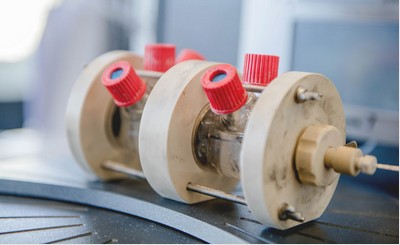Nov
21
Catalyst Found To Recycle Carbon Dioxide
November 21, 2018 | Leave a Comment
Researchers from Ruhr-Universität Bochum (RUB), Fritz-Haber Institute Berlin and Fraunhofer Umsicht in Oberhausen have found a catalyst for carbon dioxide recycling using the mineral pentlandite. Pentlandite may also be a conceivable alternative to expensive precious metal catalysts.

The researchers carried out the experiments in this electrolysis cell. Image Credit: Marquard, RUB. Click image for the largest view.
By adding a suitable solvent, the researchers successfully utilized pentlandite to convert carbon dioxide into carbon monoxide, a common source material in the chemical industry.
The research team headed by Dr. Ulf-Peter Apfel, Chair of Inorganic Chemistry I in Bochum, described the findings together with their colleagues with a paper published in the journal Chemical Science.
Apfel said, “The conversion of CO2 into valuable source materials for the chemical industry is a promising approach to combating climate change. However, we currently don’t know many cheap and readily available catalysts for CO2 reduction.” Moreover, potentially suitable catalysts primarily facilitate another chemical reaction, i.e. the synthesis of hydrogen – these including pentlandite. Nevertheless, the researchers have successfully converted the mineral to be a CO2 catalyst.
They generated electrodes from pentlandite and analyzed under which conditions production of hydrogen or carbon monoxide took place at their surface.
“The decisive factor was water being present at the electrode surface,” summarized Ulf-Peter Apfel. A lot of water shifted the reaction towards hydrogen production, a little water towards carbon monoxide production. By adjusting the water content, the researchers were thus able to generate carbon monoxide and hydrogen mixtures. “Synthetic gas mixtures like this one play a crucial role in the chemical industry,” pointed out Apfel.
Pentlandite consists of iron, nickel and sulfur and resembles catalytically active enzyme centers that occur in nature, such as hydrogen-producing hydrogenases. “A huge advantage of this mineral is the fact that it remains stable when confronted with other chemical compounds that occur in industrial emissions and are poison to many catalysts,” explained Apfel.
This find might take out some of the fear that’s driving the global warming folks. Lots of CO2 could be recycled from stationary sources and used to produce other products. If this will scale up the biologists might want to speak up about pulling the planet’s plant food out of the air. One wouldn’t want the CO2 level to decline much.

